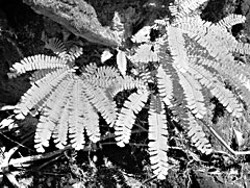[
{
"name": "Top Stories Video Pair",
"insertPoint": "7",
"component": "17087298",
"parentWrapperClass": "fdn-ads-inline-content-block",
"requiredCountToDisplay": "1"
}
]
A human female is diploid, having paired maternal and paternal chromosomes. She is born with over a million haploid eggs with unpaired chromosomes. Each egg has the potential of being fertilized by a haploid sperm.
A fern’s life cycle is more complex. It alternates generations between a large diploid “sporophyte” plant that produces haploid spores and a small haploid “gametophyte” plant, grown from a spore, that produces sperm and egg gametes. A sperm swims through water to fertilize an egg which then grows into the familiar fern. The gametophyte is inconspicuous because it is smaller than a finger nail, is photosynthetic green and has a relatively short life (measured in months).
Ferns are shade-tolerant and thus common in our forests. They are also quick to recolonize burnt forests. Asteroidal impacts and their fires that terminated the Triassic and Cretaceous Periods allowed ferns to flourish for several years, as documented by spores preserved in sediments.
Mosses alternate generations after the fashion of ferns, but their gametophytes are larger than their sporophytes, and mosses are not vascular (they lack plumbing).
Speaking of Science
-

HSU Expanding Curriculum with Polytechnic Push
Jun 15, 2021 -

Davos Won't Save Us
Jan 23, 2020 -

The Need to Study Weed
Jan 16, 2020 - More »
more from the author
-
Nuclear Matters
- May 6, 2010
-
Sophie Smells a Shaker
- Feb 4, 2010
-
The Roots of Love
- Feb 5, 2009
- More »
































